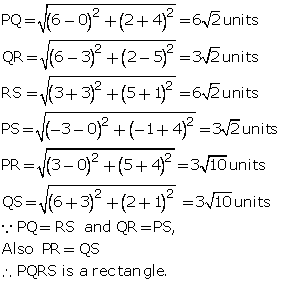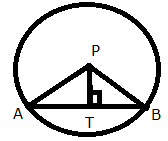SELINA Solutions for Class 9 Maths Chapter 28 - Distance Formula
Chapter 28 - Distance Formula Exercise Ex. 28
Find the distance between the following pairs of points:
(i) (-3, 6) and (2, -6)
(ii) (-a, -b) and (a, b)
(iii) ![]() and
and ![]()
(iv) ![]() and
and ![]()
(i) (-3, 6) and (2, -6)
Distance between the given points

(ii) (-a, -b) and (a, b)
Distance between the given points

(iii) ![]() and
and ![]()
Distance between the given points

(iv) ![]() and
and ![]()
Distance between the given points

Find the distance between the origin and the point:
(i) (-8, 6) (ii) (-5, -12) (iii) (8, -15)
Coordinates of origin are O (0, 0).
(i) A (-8, 6)
AO = ![]()
(ii) B (-5, -12)
BO = ![]()
(iii) C (8, -15)
CO = ![]()
The distance between the points (3, 1) and (0, x) is 5. Find x.
It is given that the distance between the points A (3, 1) and B (0, x) is 5.

Find the co-ordinates of points on the x-axis which are at a distance of 17 units from the point (11, -8).
Let the coordinates of the point on x-axis be (x, 0).
From the given information, we have:

Thus, the required co-ordinates of the points on x-axis are (26, 0) and (-4, 0).
Find the co-ordinates of the points on the y-axis, which are at a distance of 10 units from the point (-8, 4).
Let the coordinates of the point on y-axis be (0, y).
From the given information, we have:

Thus, the required co-ordinates of the points on y-axis are (0, 10) and (0, -2).
A point A is at a distance of ![]() unit from the point (4, 3). Find the co-ordinates of point A, if its ordinate is twice its abscissa.
unit from the point (4, 3). Find the co-ordinates of point A, if its ordinate is twice its abscissa.
It is given that the co-ordinates of point A are such that its ordinate is twice its abscissa.
So, let the co-ordinates of point A be (x, 2x).
We have:

Thus, the co-ordinates of the point A are (1, 2) and (3, 6).
A point P (2, -1) is equidistant from the points (a, 7) and (-3, a). Find a.
Given that the point P (2, -1) is equidistant from the points A (a, 7) and B (-3, a).

What point on the x-axis is equidistant from the points (7, 6) and (-3, 4)?
Let the co-ordinates of the required point on x-axis be P (x, 0).
The given points are A (7, 6) and B (-3, 4).
Given, PA = PB

Thus, the required point is (3, 0).
Find a point on the y-axis which is equidistant from the points (5, 2) and (-4, 3).
Let the co-ordinates of the required point on y-axis be P (0, y).
The given points are A (5, 2) and B (-4, 3).
Given, PA = PB

Thus, the required point is (0, -2).
A point P lies on the x-axis and another point Q lies on the y-axis.
(i) Write the ordinate of point P.
(ii) Write the abscissa of point Q.
(iii) If the abscissa of point P is -12 and the ordinate of point Q is -16; calculate the length of line segment PQ.
(i) Since, the point P lies on the x-axis, its ordinate is 0.
(ii) Since, the point Q lies on the y-axis, its abscissa is 0.
(iii) The co-ordinates of P and Q are (-12, 0) and (0, -16) respectively.
PQ = ![]()
Show that the points P (0, 5), Q (5, 10) and R (6, 3) are the vertices of an isosceles triangle.

Since, PQ = QR, ![]() PQR is an isosceles triangle.
PQR is an isosceles triangle.
Prove that the points P(0, -4), Q(6, 2), R(3, 5) and S(-3, -1) are the vertices of a rectangle PQRS.

Prove that the points A (1, -3), B (-3, 0) and C (4, 1) are the vertices of an isosceles right-angled triangle. Find the area of the triangle.

Show that the points A (5, 6), B (1, 5), C (2, 1) and D (6, 2) are the vertices of a square ABCD.

Since, AB = BC = CD = DA and AC = BD,
A, B, C and D are the vertices of a square.
Show that (-3, 2), (-5, -5), (2, -3) and (4, 4) are the vertices of a rhombus.
Let the given points be A (-3, 2), B (-5, -5), C (2, -3) and D (4, 4).

Since, AB = BC = CD = DA and AC ![]() BD
BD
The given vertices are the vertices of a rhombus.
Points A (-3, -2), B (-6, a), C (-3, -4) and D (0, -1) are the vertices of quadrilateral ABCD; find a if 'a' is negative and AB = CD.
AB = CD
AB2 = CD2
(-6 + 3)2 + (a + 2)2 = (0 + 3)2 + (-1 + 4)2
9 + a2 + 4 + 4a = 9 + 9
a2 + 4a - 5 = 0
a2 - a + 5a - 5 = 0
a(a - 1) + 5 (a - 1) = 0
(a - 1) (a + 5) = 0
a = 1 or -5
It is given that a is negative, thus the value of a is -5.
The vertices of a triangle are (5, 1), (11, 1) and (11, 9). Find the co-ordinates of the circumcentre of the triangle.
Let the circumcentre be P (x, y).
Then, PA = PB
PA2 = PB2
(x - 5)2 + (y - 1)2 = (x - 11)2 + (y - 1)2
x2 + 25 - 10x = x2 + 121 - 22x
12x = 96
x = 8
Also, PA = PC
PA2 = PC2
(x - 5)2 + (y - 1)2 = (x - 11)2 + (y - 9)2
x2 + 25 - 10x + y2 + 1 - 2y = x2 + 121 - 22x + y2 + 81 - 18y
12x + 16y = 176
3x + 4y = 44
24 + 4y = 44
4y = 20
y = 5
Thus, the co-ordinates of the circumcentre of the triangle are (8, 5).
Given A = (3, 1) and B = (0, y - 1). Find y if AB = 5.
AB = 5
AB2 = 25
(0 - 3)2 + (y - 1 - 1)2 = 25
9 + y2 + 4 - 4y = 25
y2 - 4y - 12 = 0
y2 - 6y + 2y - 12 = 0
y(y - 6) + 2(y - 6) = 0
(y - 6) (y + 2) = 0
y = 6, -2
Given A = (x + 2, -2) and B (11, 6). Find x if AB = 17.
AB = 17
AB2 = 289
(11 - x - 2)2 + (6 + 2)2 = 289
x2 + 81 - 18x + 64 = 289
x2 - 18x - 144 = 0
x2 - 24x + 6x - 144 = 0
x(x - 24) + 6(x - 24) = 0
(x - 24) (x + 6) = 0
x = 24, -6
The centre of a circle is (2x - 1, 3x + 1). Find x if the circle passes through (-3, -1) and the length of its diameter is 20 unit.
Distance between the points A (2x - 1, 3x + 1) and B (-3, -1) = Radius of circle
![]() AB = 10 (Since, diameter = 20 units, given)
AB = 10 (Since, diameter = 20 units, given)
AB2 = 100
(-3 - 2x + 1)2 + (-1 - 3x - 1)2 = 100
(-2 - 2x)2 + (-2 - 3x)2 = 100
4 + 4x2 + 8x + 4 + 9x2 + 12x = 100
13x2 + 20x - 92 = 0

The length of line PQ is 10 units and the co-ordinates of P are (2, -3); calculate the co-ordinates of point Q, if its abscissa is 10.
Let the co-ordinates of point Q be (10, y).
PQ = 10
PQ2 = 100
(10 - 2)2 + (y + 3)2 = 100
64 + y2 + 9 + 6y = 100
y2 + 6y - 27 = 0
y2 + 9y - 3y - 27 = 0
y(y + 9) - 3(y + 9) = 0
(y + 9) (y - 3) = 0
y = -9, 3
Thus, the required co-ordinates of point Q are (10, -9) and (10, 3).
Point P (2, -7) is the centre of a circle with radius 13 unit, PT is perpendicular to chord AB and T = (-2, -4); calculate the length of:
(i) AT (ii) AB.

(i) Given, radius = 13 units
![]() PA = PB = 13 units
PA = PB = 13 units
Using distance formula,

Using Pythagoras theorem in ![]() PAT,
PAT,
AT2 = PA2 - PT2 = 169 - 25 = 144
AT = 12 units
(ii) We know that the perpendicular from the centre of a circle to a chord bisects the chord.
![]() AB = 2AT = 2
AB = 2AT = 2 ![]() 12 units = 24 units
12 units = 24 units
Calculate the distance between the points P (2, 2) and Q (5, 4) correct to three significant figures.

Calculate the distance between A (7, 3) and B on the x-axis whose abscissa is 11.
We know that any point on x-axis has coordinates of the form (x, 0).
Abscissa of point B = 11
Since, B lies of x-axis, so its co-ordinates are (11, 0).

Calculate the distance between A (5, -3) and B on the y-axis whose ordinate is 9.
We know that any point on y-axis has coordinates of the form (0, y).
Ordinate of point B = 9
Since, B lies of y-axis, so its co-ordinates are (0, 9).

Find the point on y-axis whose distances from the points A (6, 7) and B (4, -3) are in the ratio 1: 2.
Let the required point on y-axis be P (0, y).

From the given information, we have:

Thus, the required points on y-axis are (0, 9) and![]() .
.
The distances of point P (x, y) from the points A (1, -3) and B (-2, 2) are in the ratio 2: 3. Show that: 5x2 + 5y2 - 34x + 70y + 58 = 0.
It is given that PA: PB = 2: 3

Hence, proved.
The points A (3, 0), B (a, -2) and C (4, -1) are the vertices of triangle ABC right angled at vertex A. Find the value of a.

Since, triangle ABC is a right-angled at A, we have:
AB2 + AC2 = BC2
![]() a2 - 6a + 13 + 2 = a2 - 8a + 17
a2 - 6a + 13 + 2 = a2 - 8a + 17
![]() 2a = 2
2a = 2
![]() a = 1
a = 1
Comments
Post a Comment